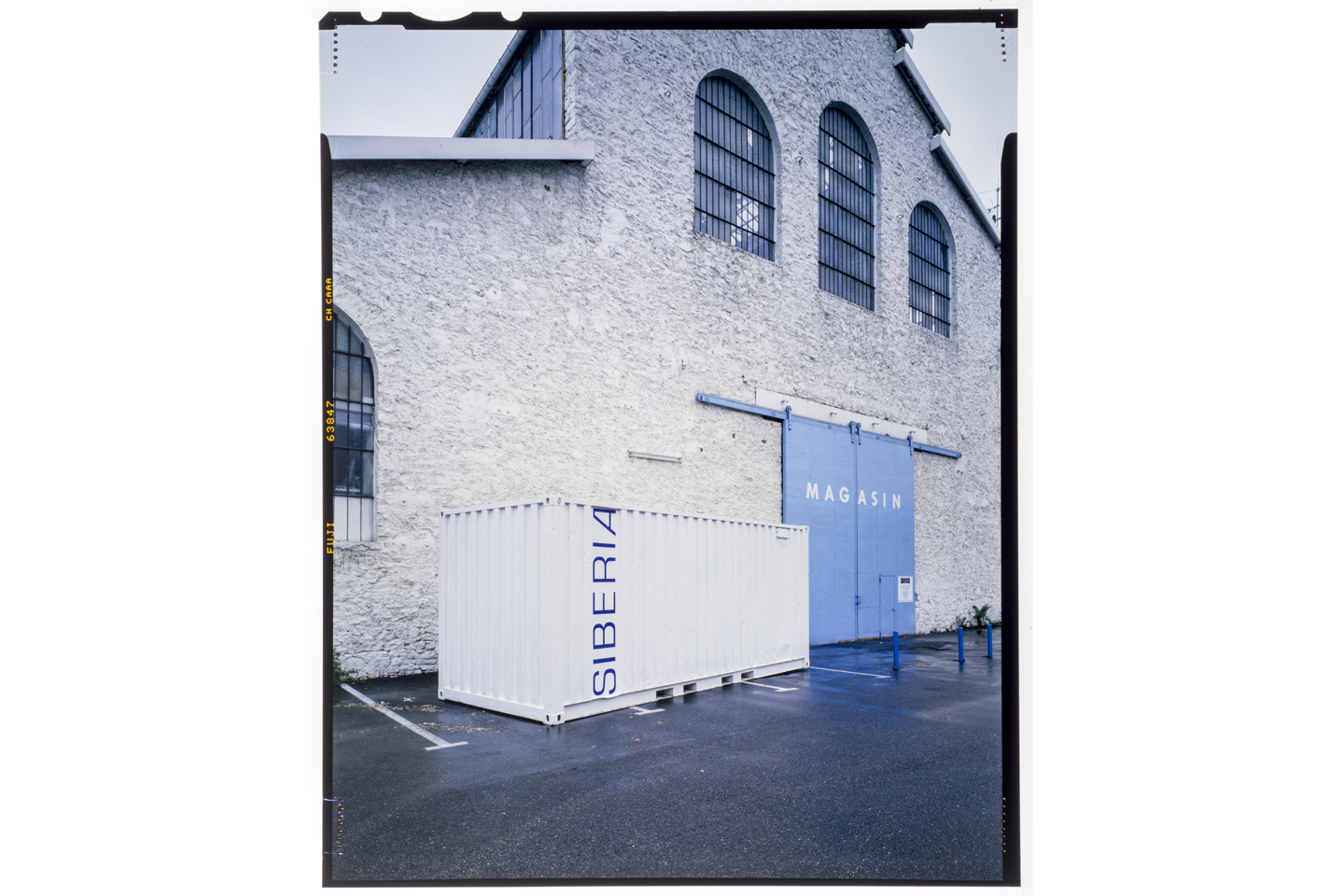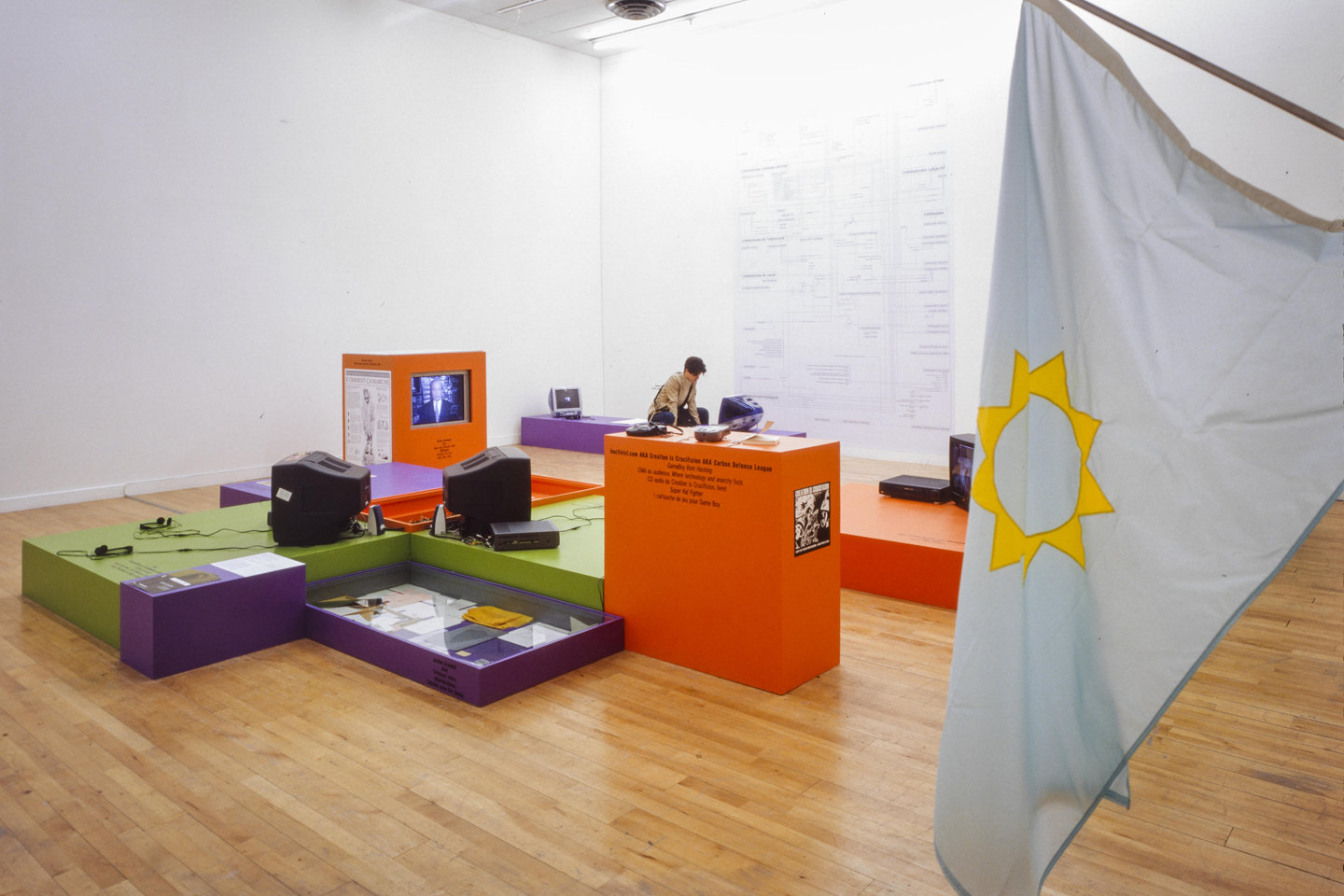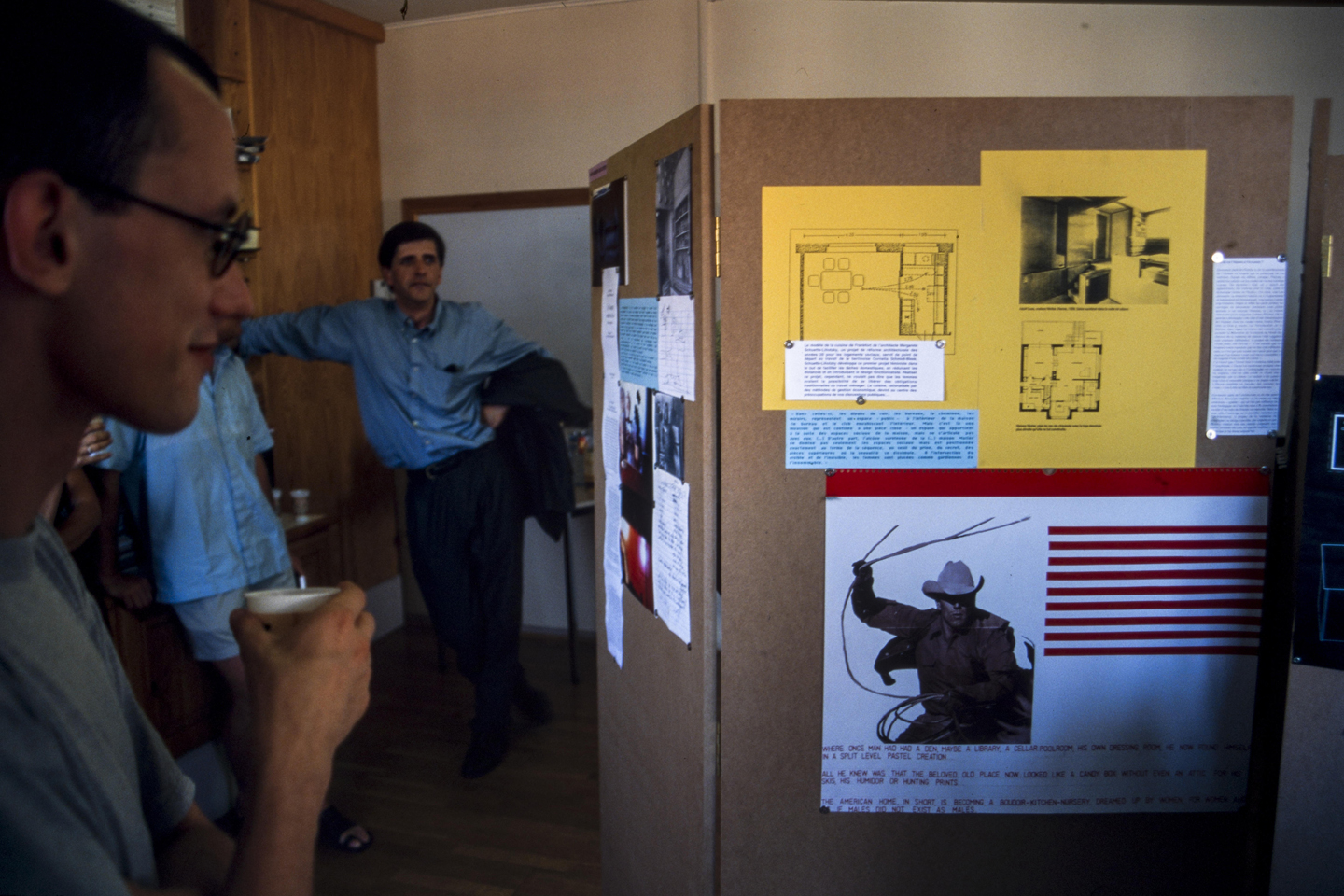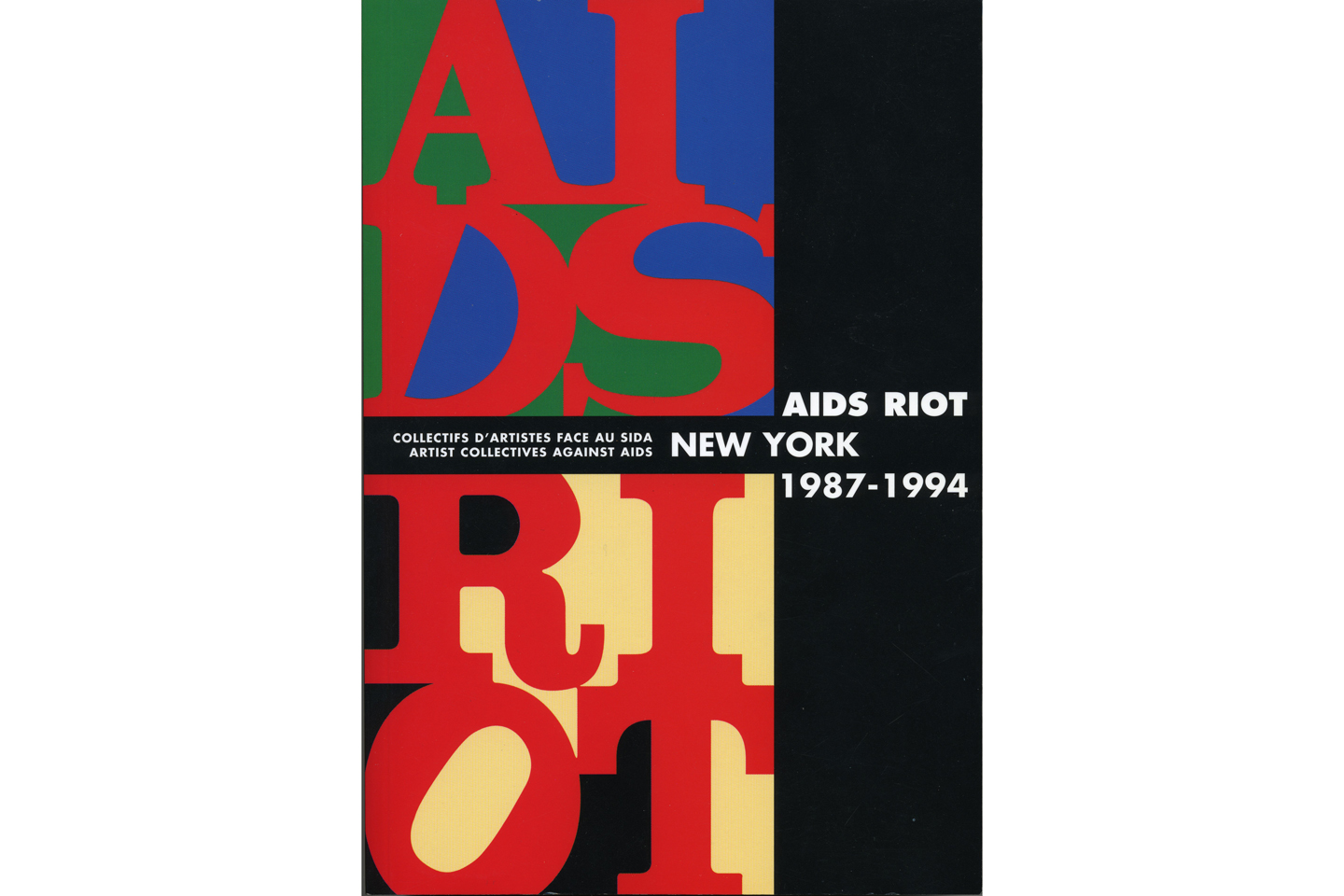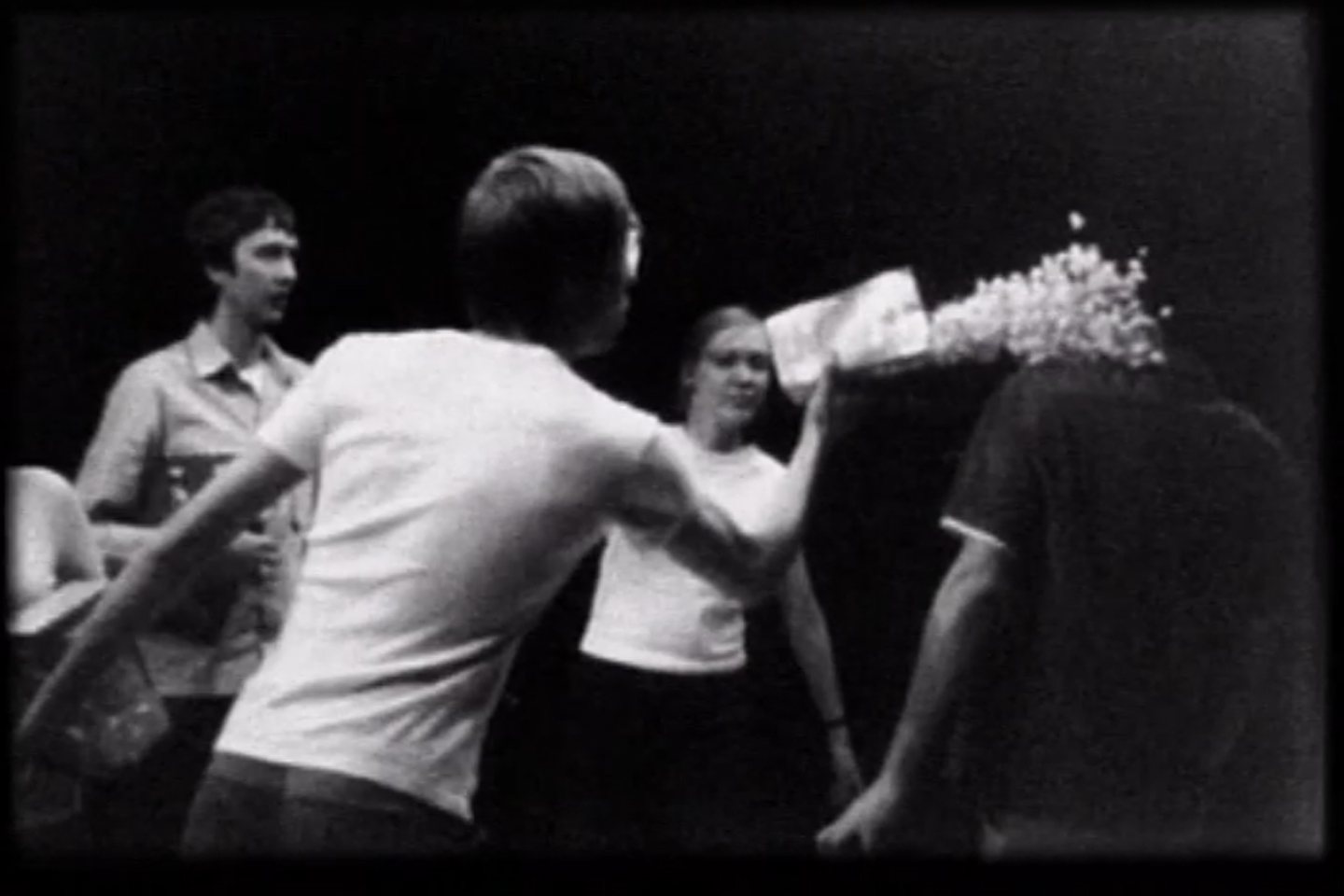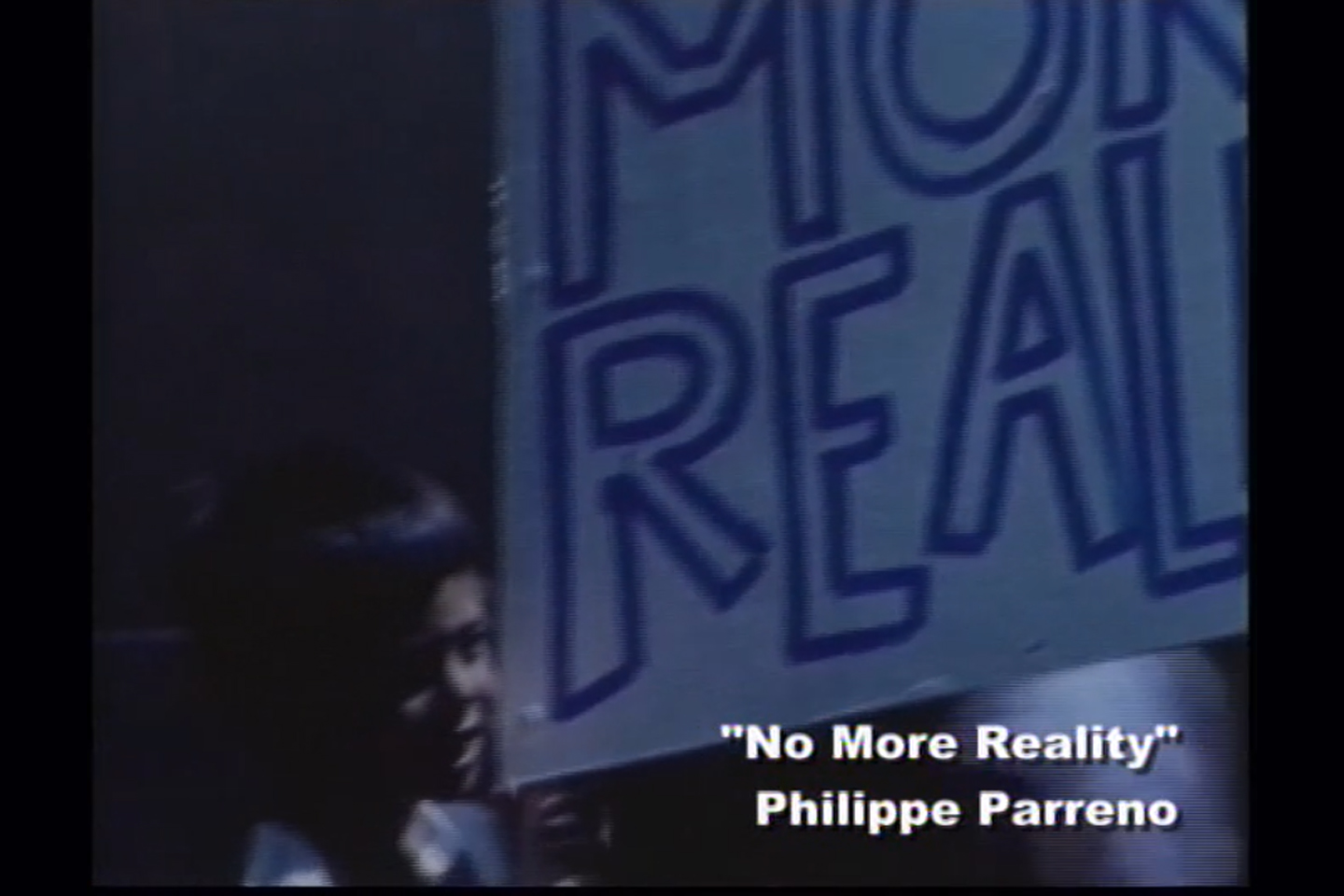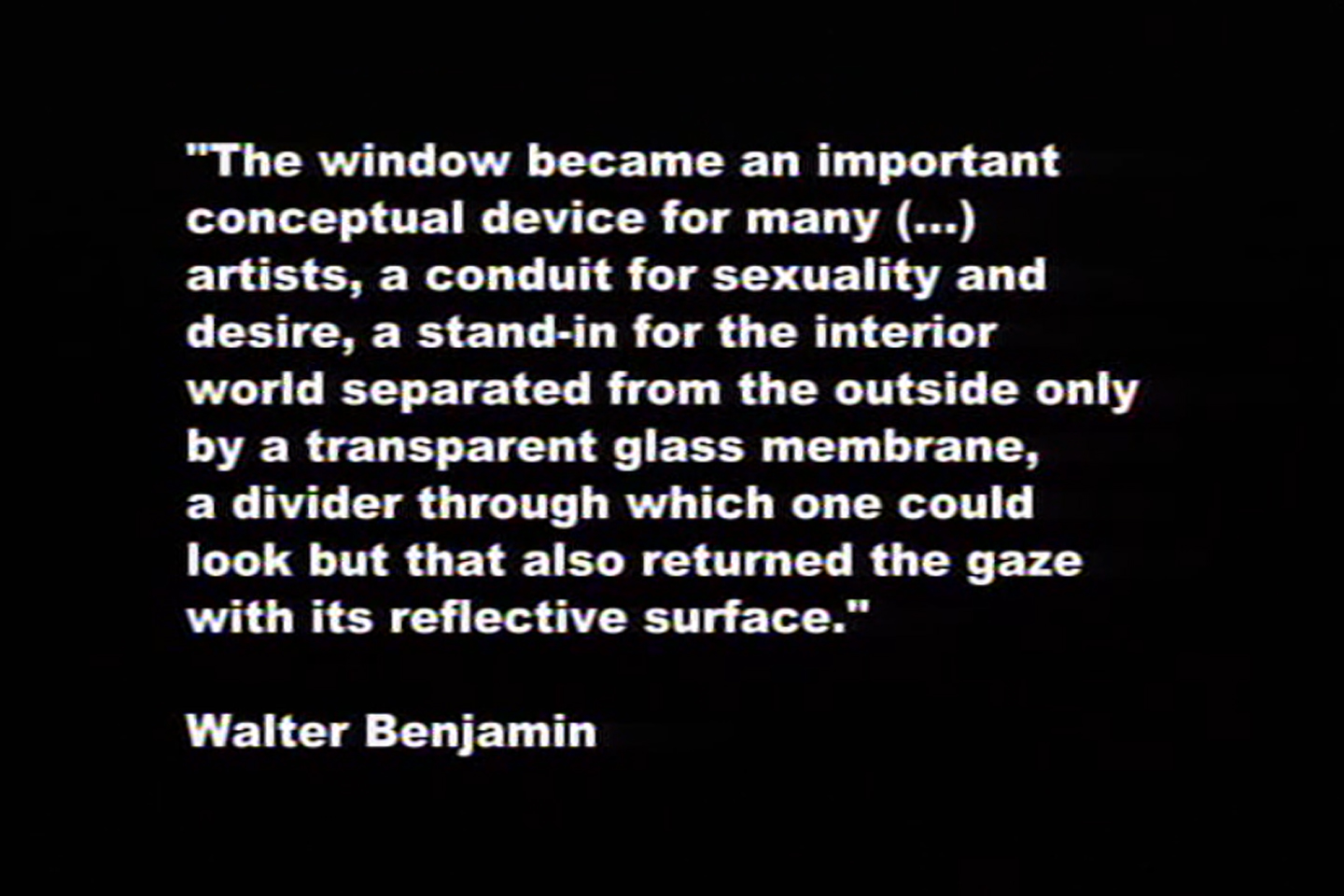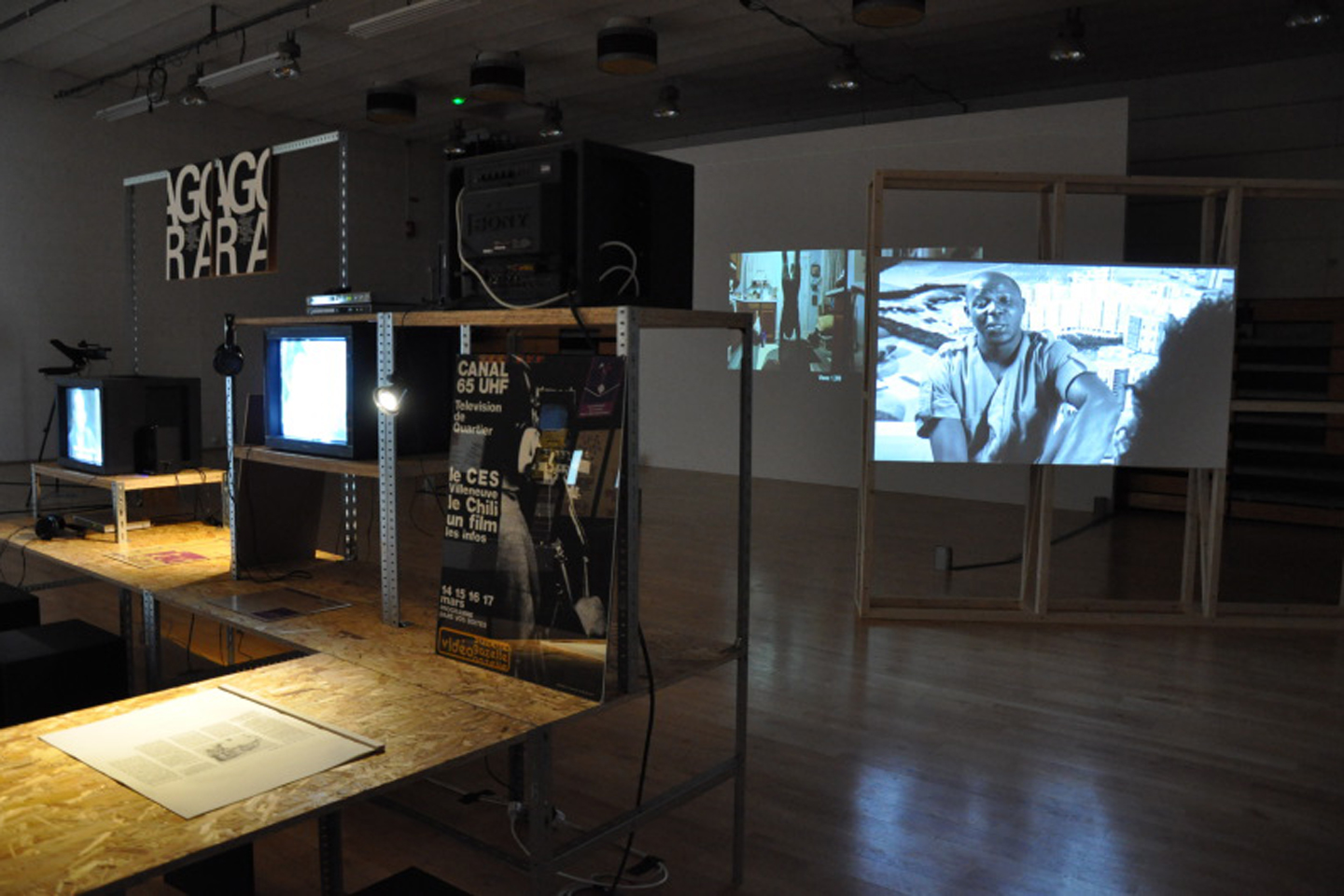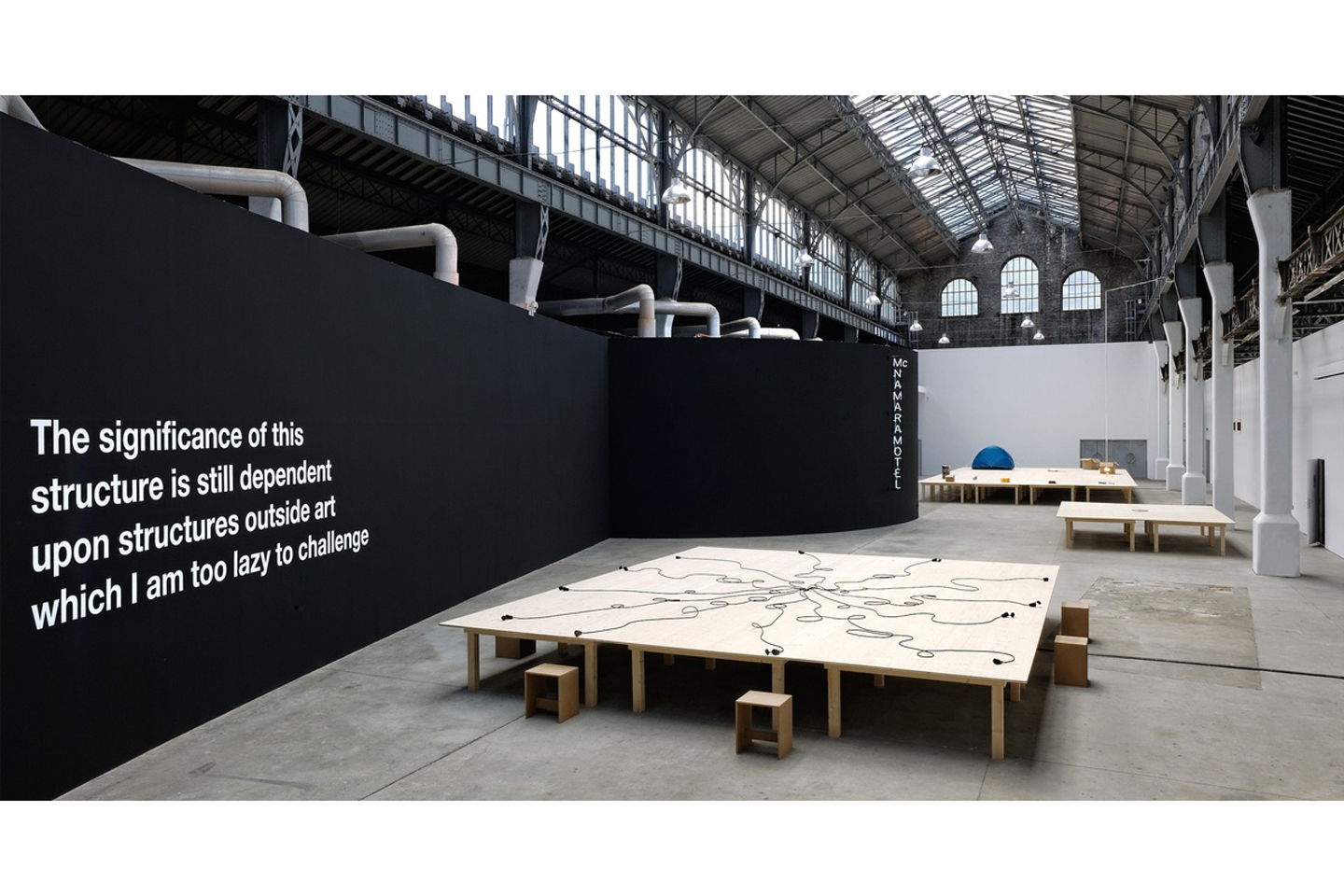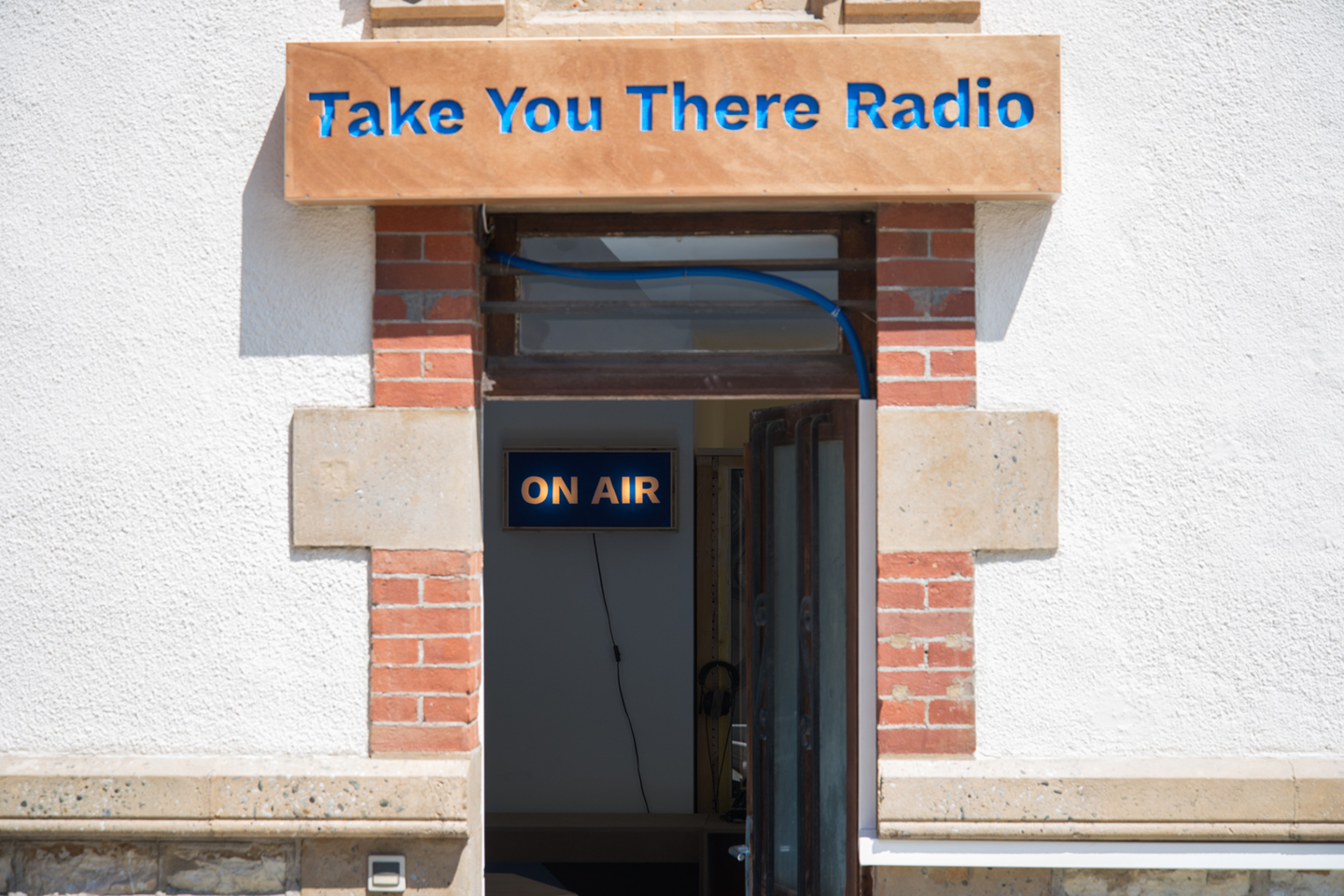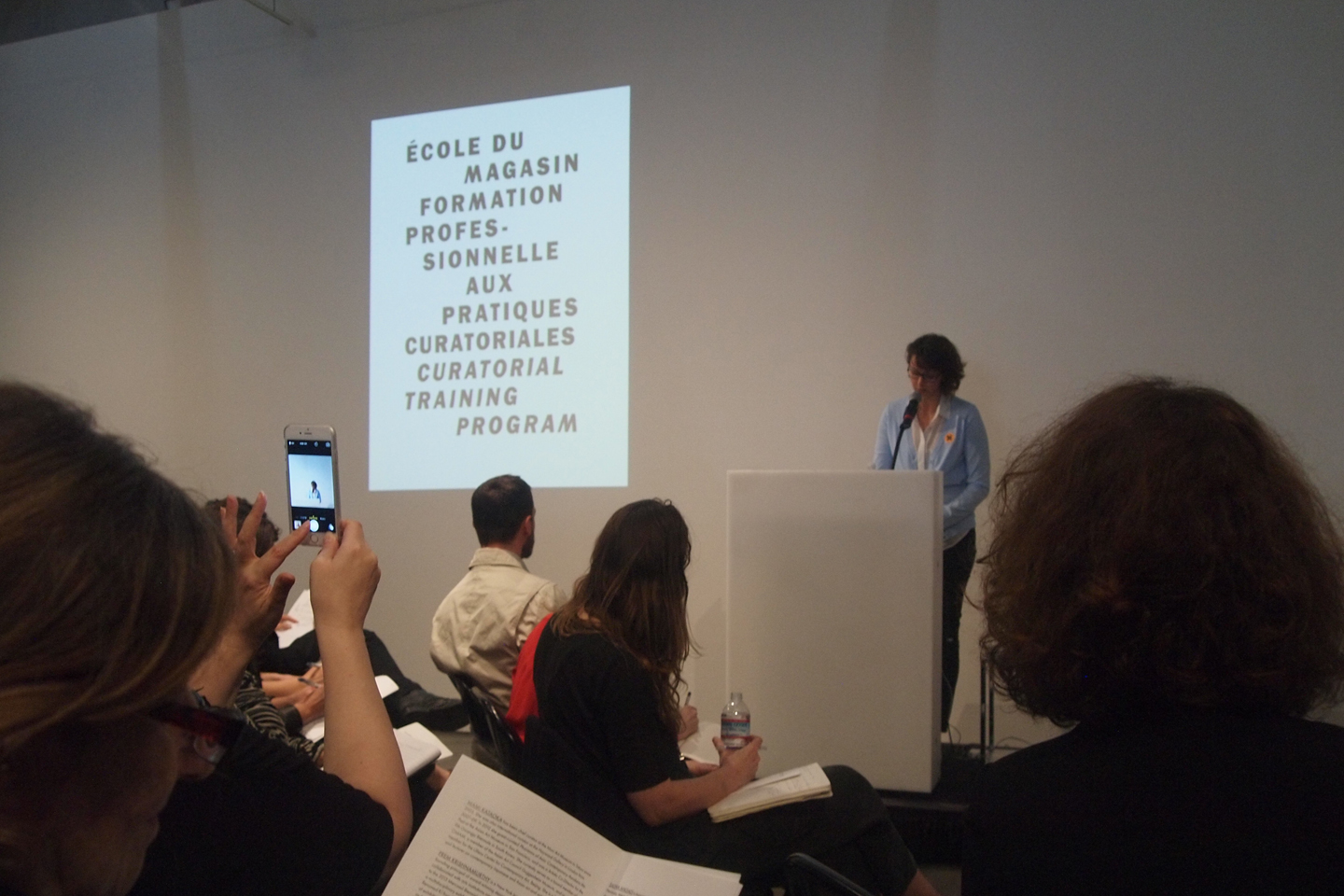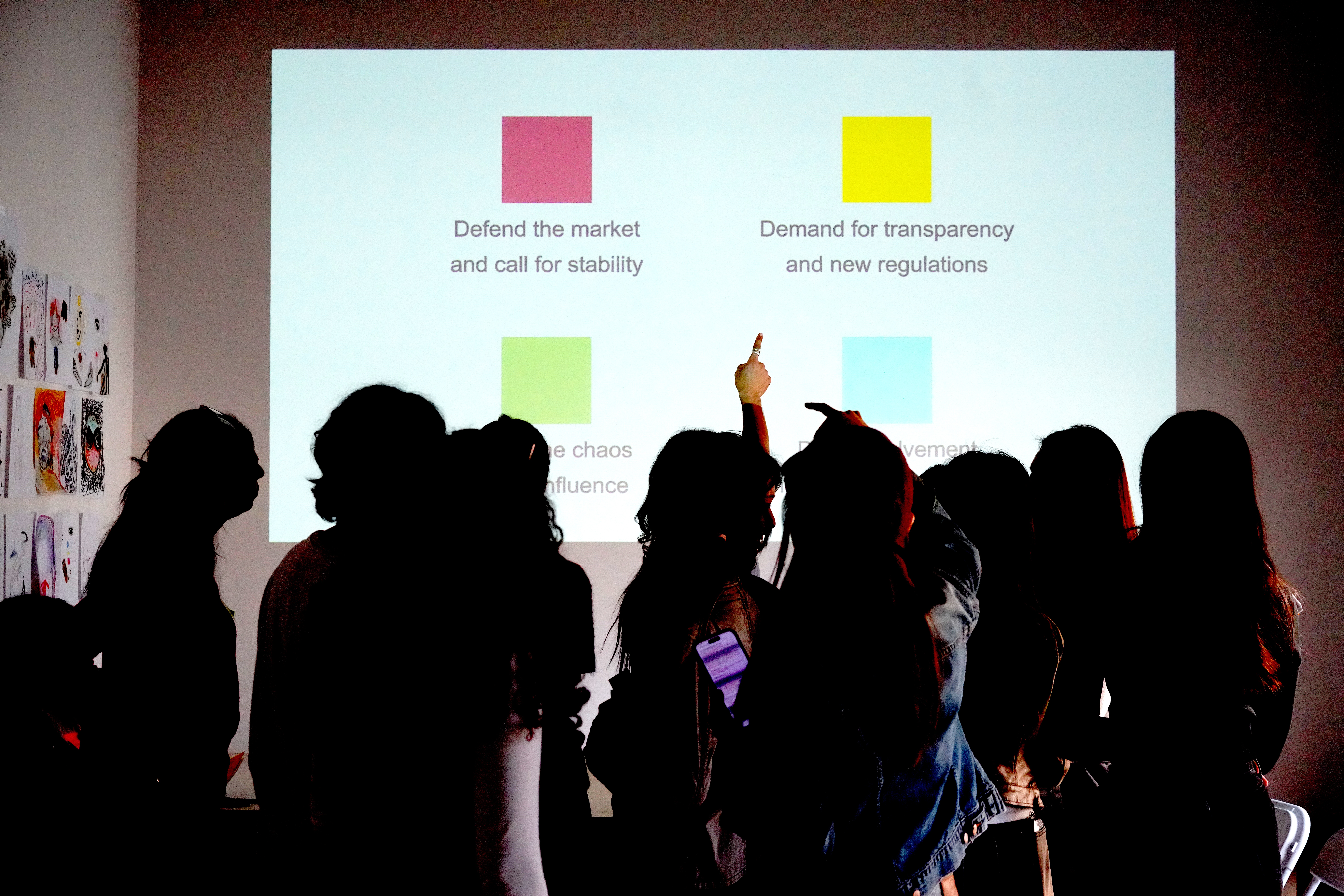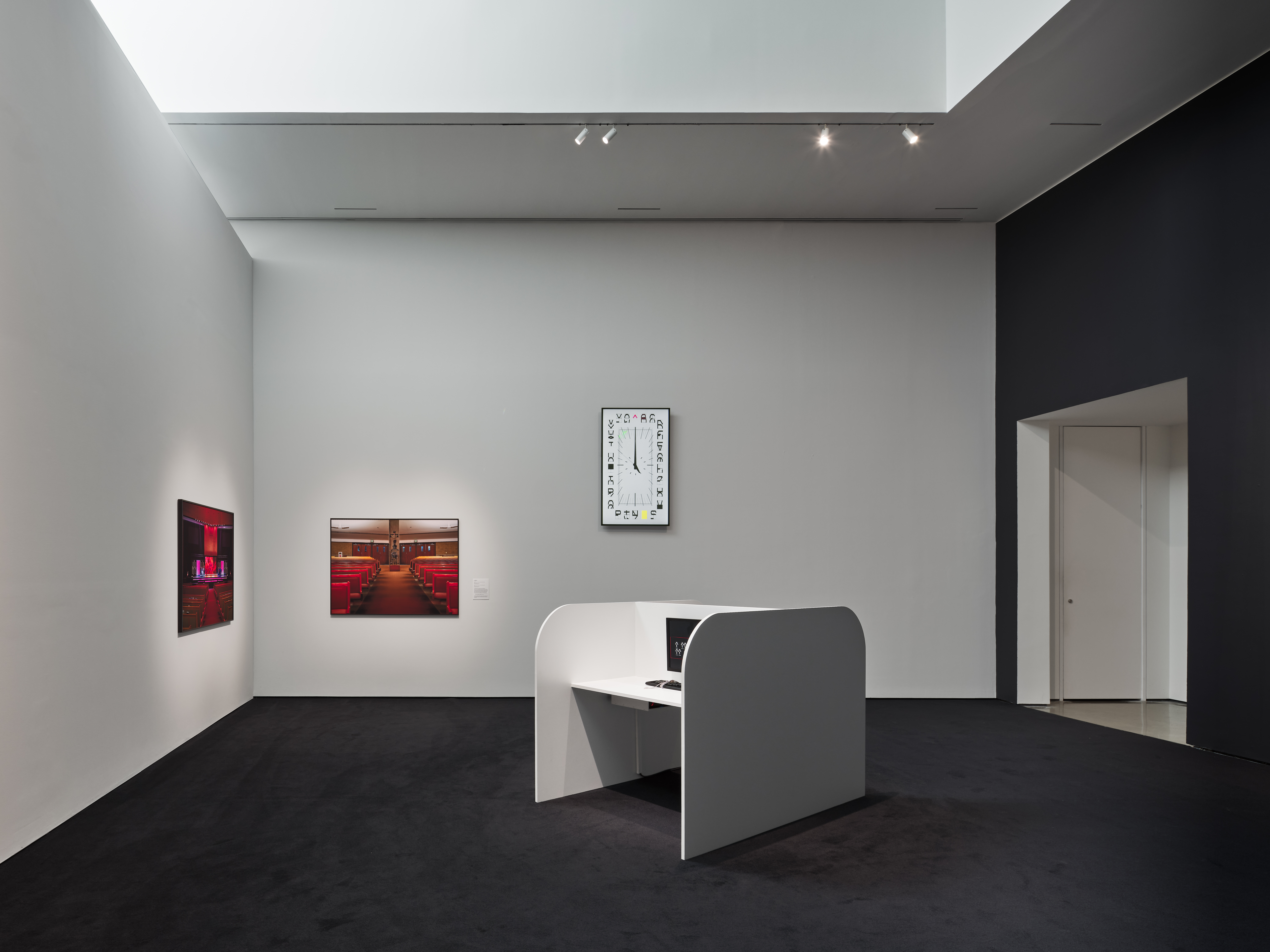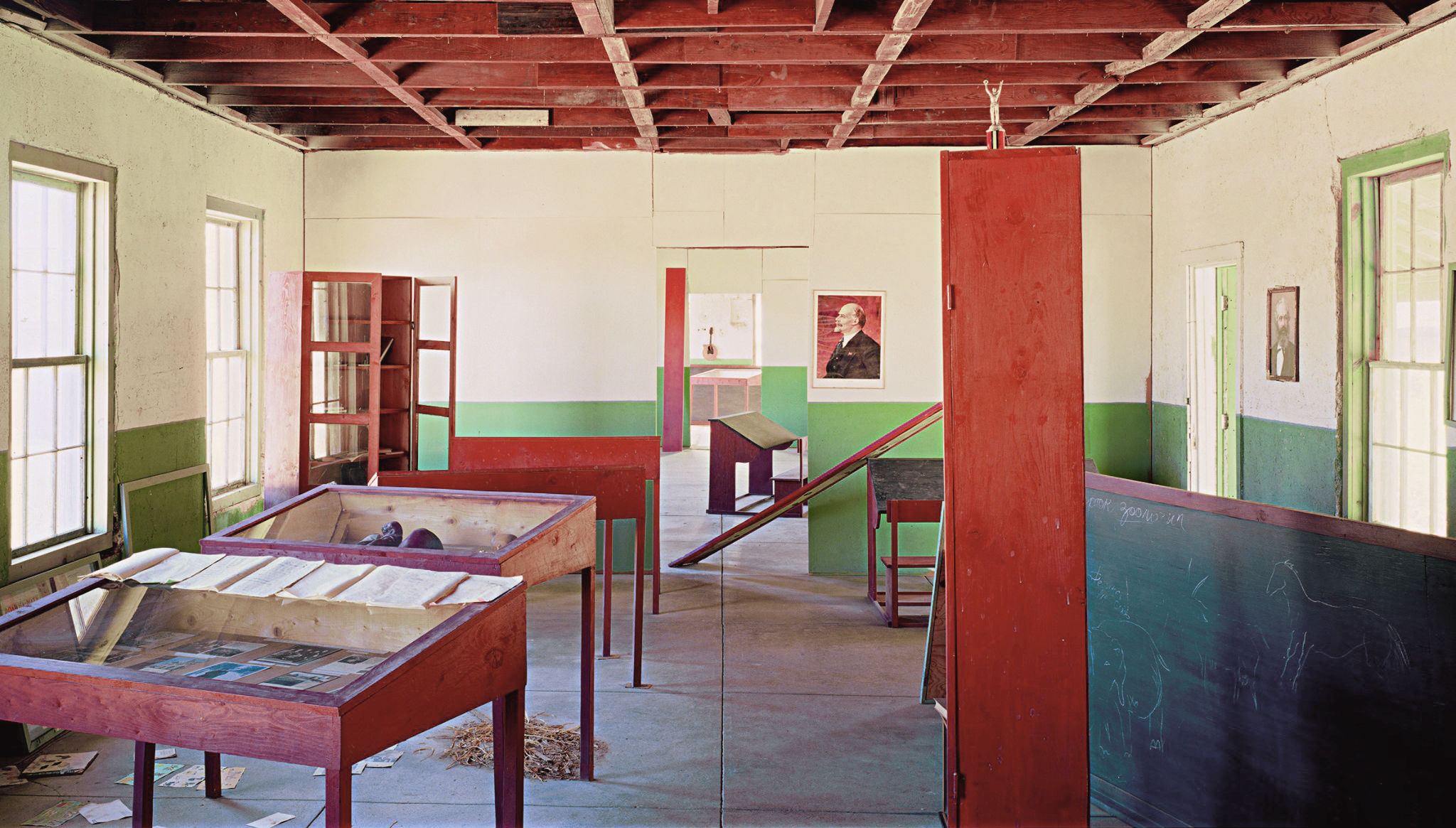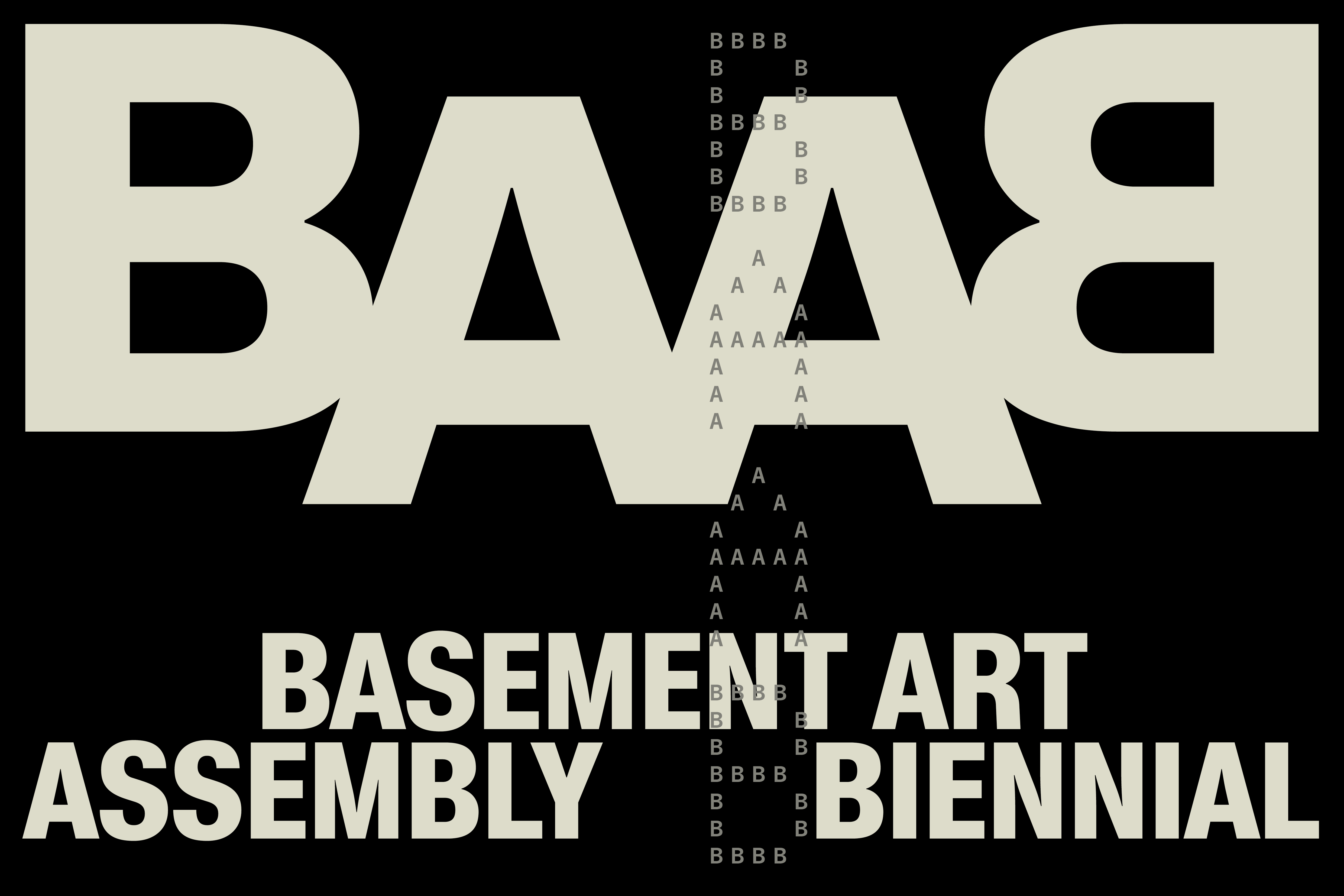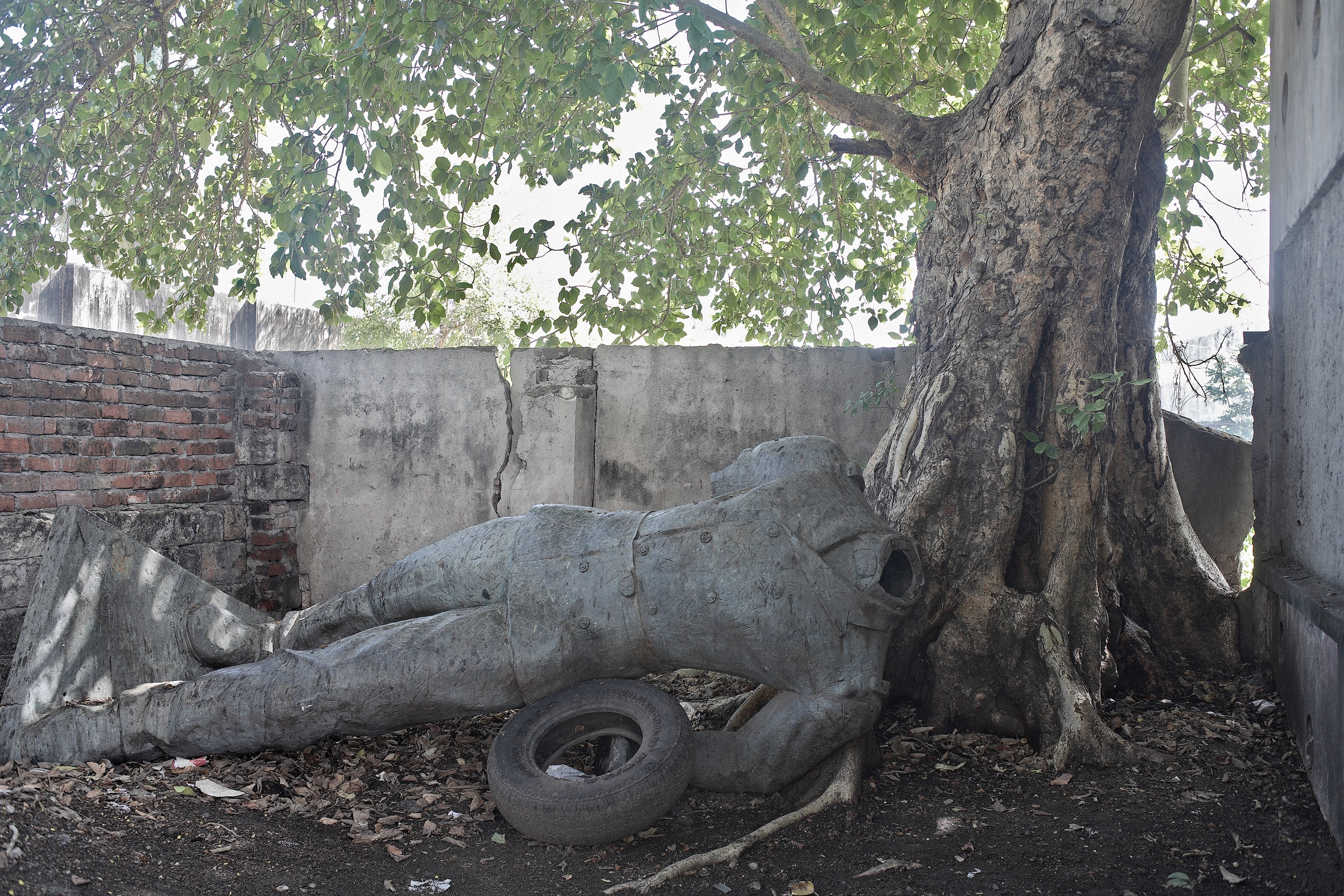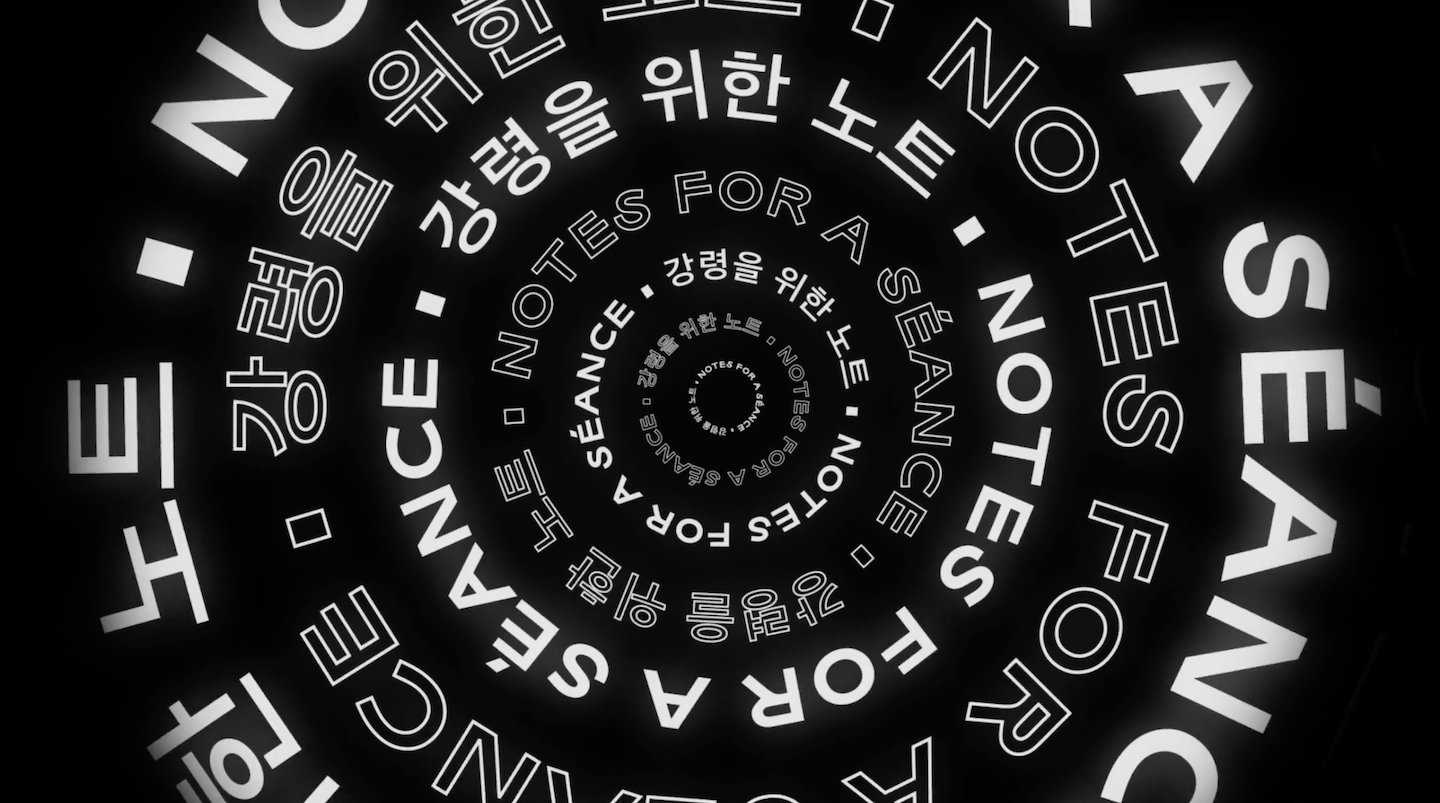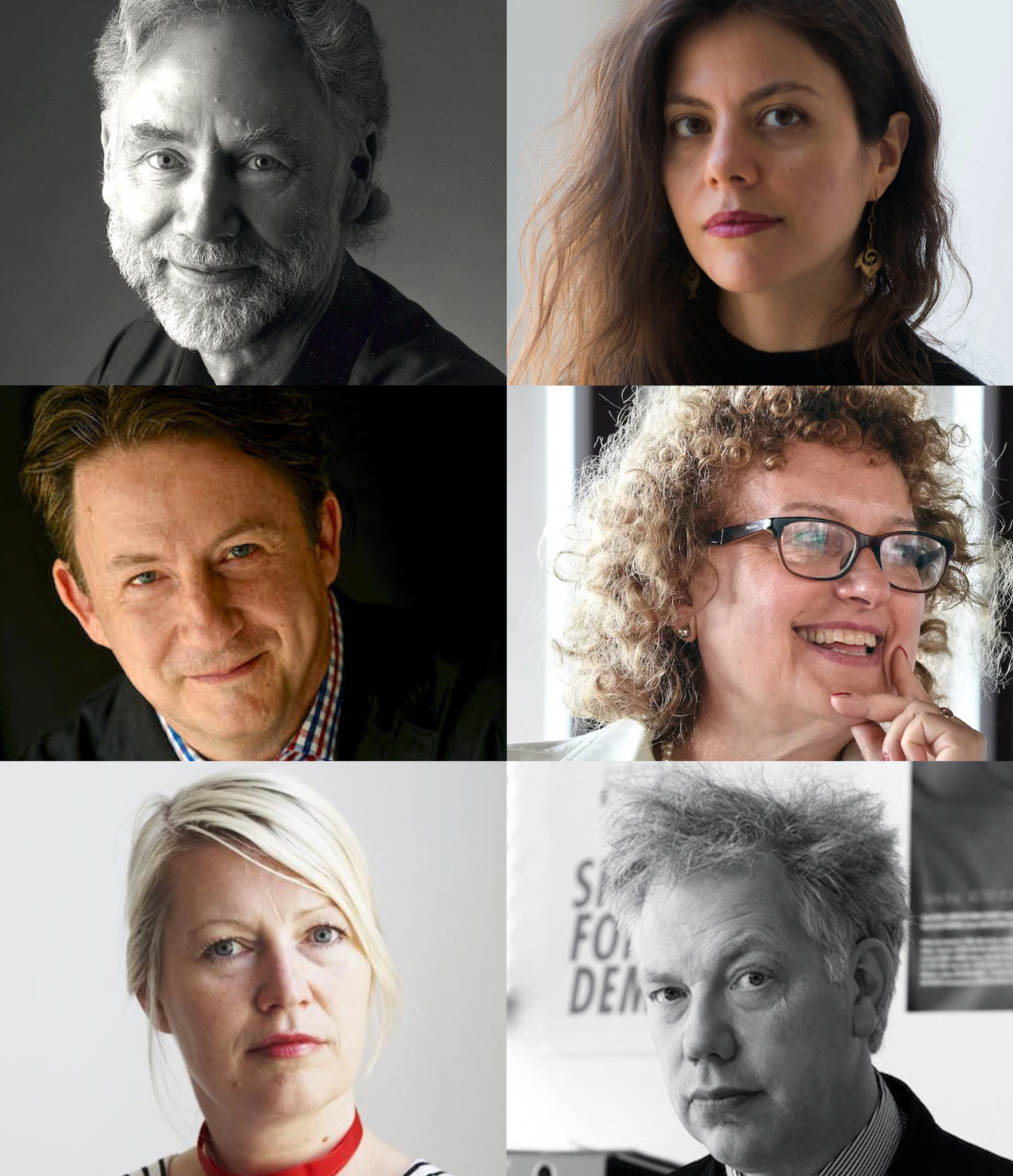A newsletter arrives on December 13, 2016, announcing a call for applications to the “Ateliers des Horizons.” A number of emails follow: the École du Magasin has come to an end, been “reinvented.”[footnote See →.] Under the new director of Le Magasin—now Magasin des Horizons—the Ateliers will offer “a professional multidisciplinary training program dedicated to arts and societies” that intends “to foster reflection on social changes, evolving professional practices, and the political challenges faced by the cultural, social, and educational sectors.” On the program of the Ateliers: physical training (dance, yoga, hiking, tai chi) combined with seminars and field trips. Nowhere in the program description does the term “curatorial” appear.
The sudden disappearance of the École du Magasin was felt by a majority of its protagonists as a misunderstanding or denial—if not an outright rejection—of its history and achievements. In response, in March 2017, a group of former participants created the Association École du Magasin Alumni, a network of participants and collaborators of the École, to continue its legacy and encourage debates on contemporary curatorial practices. That summer, the association suggested the board of the Magasin des Horizons transfer the École’s archives to an institution specializing in the preservation of archives of contemporary art. This proposal was rejected, and by February 2018 confirmation arrived that the archives of both the École du Magasin and Le Magasin would be moved to the local administrative Archives Départementales de l’Isère in Grenoble.
In December 2017, Damien Airault, Michela Alessandrini, Lore Gablier, Estelle Nabeyrat, Ekaterina Shcherbakova, and Asli Seven formed a research group to foster the École’s pedagogical history. The group participated in the first residency program offered by the Institut National d’Histoire de l’Art (INHA) in Paris in spring 2018.[footnote See →. Because of the threat to the École’s legacy and the group’s mission to keep it alive, composing an oral archive of the École’s community emerged as the natural working methodology within the research project Calling Back: l’École du Magasin (1987–2016).
This text is the first part of a paper published from the group’s research, and is a collaboration between Michela Alessandrini, Lore Gablier, and Estelle Nabeyrat. In the spirit of the École, we have worked in close collaboration to gather multiple interpretations on “how fitting” the end of the École du Magasin can be understood, taking advantage of the various viewpoints and areas of interest that we have as researchers, curators, and art workers. Our purpose is to dive into the history of the École du Magasin and, little by little, put it in perspective. The text is partially based on our own experience as former participants and coordinators and on the archival material we have collected and interviews we have conducted since December 2017. The reflections presented here are meant to not only raise awareness of the necessity of sharing the narratives in these archives but also to shed light on the pivotal role of curatorial pedagogical methodologies in understanding broader societal dynamics as they are mirrored and embedded in art institutions’ behavior.
The project of creating an art center in Grenoble was entrusted to Jacques Guillot in July 1985.[footnote Pierre Gaudibert, director of the Musée de Grenoble, first conceived a center for contemporary art as a possible extension of the museum in 1977.] Director of the gallery space Espace Arts Plastiques in Villeparisis in Paris’s northeastern suburbs from 1978 to 1983 and member of the commission responsible for decentralizing the visual arts in France, Guillot had recently joined the Ministry of Culture’s Délégation aux Arts Plastiques.[footnote Created in May 1982 as part of the Ministry of Culture, the Délégation aux Arts Plastiques was responsible for defining and implementing the state’s policy for fine arts and other forms of expression and encouraging their promotion to the public.] His initial task was to evaluate the possibility of installing the art center within Grenoble’s Halle Bouchayer-Viallet, which the city government identified as a possible premises. This peculiar building, the steel structure of which was designed by the Eiffel workshops for the 1900 Paris Universal Exhibition, was entirely dismountable and brought to Grenoble by the industrialists Joseph Bouchayer and Félix Viallet, where it formed part of an industrial complex. After the factory ceased operations in the second half of the twentieth century—a common ancestry of many art spaces—the building was abandoned until the city purchased it in 1980. Upon entering, Guillot’s immediate reaction was skeptical to say the least, having likely sensed what would remain a persistent problem: the financial abyss of heating a space of three thousand square meters. Soon, however, under pressure from the Parti Socialiste city government, Guillot settled on the Halle Bouchayer-Viallet, and the new Le Magasin joined the Musée de Grenoble and the École Supérieure d’Art on Grenoble’s cultural landscape.
While designing the agenda of Le Magasin, Jacques Guillot included a training program that would bring together exhibition-making, public programming, and education in a unique, and at the time, extremely innovative manner. In the official proposal to President François Mitterrand from October 1985, Guillot stated that the purpose of the École was “to instruct upcoming médiateurs at an international level, thus giving French art a recognition it partially lacks—through a thorough knowledge of contemporary art, a rigorous examination of its various audiences, and a flexible attitude towards the economy and other cultural fields.”[footnote Quoted from the original project proposal by Jacques Guillot. The document is part of the archive material collected for Calling Back: École du Magasin (1987–2016).] The École was a crucial component of Guillot’s vision for the art center: not only would it respond to the growing need for young art professionals in France but it would also contribute to the influence of the art center on the international contemporary art scene. Alumni would become ambassadors of Le Magasin and its École, as well as of an emerging art world in France and beyond.
Also in his project proposal for Le Magasin, Guillot cited Centre Georges Pompidou curator Jean-Hubert Martin as a model for the institution’s leadership for his insistence on going beyond the intellectual and aesthetic categories defined by Western art history. Years before “Magiciens de La Terre,” the landmark 1989 exhibition Martin presented at the Centre Pompidou and the Grande Halle de la Villette in Paris, Guillot anticipated the need to expand the accepted Eurocentric perspective. In that time of political and cultural excitement, exploring the arts of the so-called “third world” not only responded to French political concerns but also accommodated the interdisciplinary zeal for “other” geographies. Though it was clear from the beginning that a wider interest in and knowledge of non-Western cultures would inspire Le Magasin’s artistic program, a clear shift in this sense never occurred.
Institutional French academia was in a state of change in the 1980s. In 1985, Pontus Hultén, the first director of the Centre Georges Pompidou, inaugurated the Institut des Hautes Études en Arts Plastiques in Paris, a center for contemporary research in artistic creation that responded to new concerns, namely knowledge transfer between practicing professionals and open experimentation as possible alternatives to the traditional idea of art school, following the model of Black Mountain College in the postwar United States. Under these premises, the École opened its doors in 1987, only a few months after Le Magasin itself was inaugurated.[footnote Le Magasin was inaugurated on April 26, 1986, with an exhibition of works by Daniel Buren and Brian Eno. A portfolio, Je suis absent jusqu’à mon retour [I’m away until I get back], was also on display and included pictures of interventions that artists Quentin Bertoux, Daniel Buren, Érik Dietman, Jean-Marie Krauth, Bertrand Lavier, Ange Leccia, Ken Lam, Pierre Mercier, Nam June Paik, Keith Sonnier, Jean-Luc Vilmouth, and Lawrence Weiner made during the building’s renovation.] In addition to Black Mountain College, both IHEAP and the École du Magasin were inspired by the Whitney Independent Study Program in New York, which in 1987, under supervisor Hal Foster, reconstituted its art history and museum studies program as two separate courses in critical studies and curating in order to develop “alternative curatorial forms.”[footnote See →.]
The École’s initial methodologies emphasized independent study, following Guillot’s very broad, informal knowledge of contemporary art, which he had acquired through exchanges with artists and peers rather than institutionalized education. The curriculum entailed study trips and meetings with key figures in contemporary art, and Yves Robert and Florence Bonnefous, participants in the first and second sessions of the École, respectively, recalled meetings with Kaspar König, Benjamin Buchloh, Jan Höet, and Harald Szeemann—a reflection of the male, white, educated art power structures that have since hopefully, gradually evolved. Apprenticeships with art professionals held two main objectives: to become familiar with the operation of an art center and its artistic community and to identify young artists with whom the École’s participants could collaborate to produce a commissioned work. Apprenticeships sought to establish true connections between the different personalities involved in artistic production and therefore encouraged dialogues and long-term relationships between curators and artists. “19&&,” the 1988 exhibition produced by the first session of the École, served as a crucial test case of this hypothesis. Eleven artists—Marie-José Burki, Eugenio Cano, Carcle Ramo Nash, Grenville Davey, Thomas Locher, Johan J. A. G. Muyle, Philippe Perrin, Caroline Russel, Siberia (Dominique Gonzalez-Foester, Bernard Joisten, Pierre Joseph, and Philippe Parreno), Patrick van Caeckenbergh, and Anthony Wilson—were selected not according to an overarching topical premise but rather, as Tirdad Zolghadr commented in his essay on the exhibition, assembled over the course of the academic year as a result of the curators’ wanderings and encounters.[footnote Tirdad Zolghadr, “Getting Started,” The Exhibitionist 5 (2012).]
Grenoble was advantageous for such wandering. The Musée de Grenoble was the first museum in France to acquire a collection of modern and contemporary art, and the city’s École Supérieure d’Art produced a generation of artists that engaged directly with Le Magasin and students of the École. (Dominique Gonzalez-Foerster, for example, was both a student at the art school and then at the École du Magasin). As Florence Bonnefous recalled in an interview[footnote See →.] with May magazine:
Before [Air de Paris] was created, it was originally at Le Magasin in Grenoble, where I met Édouard [Merino], to whom I then introduced Éric Troncy, who was already a friend of mine, and who consequently met Nicolas Bourriaud, who was a friend of Édouard’s. Then all of us met Philippe Parreno, Pierre Joseph, Bernard Joisten, Dominique Gonzalez-Foerster, and Philippe Perrin. It’s interesting to remember these artists not as starlets from Grenoble, but for the whole body of collaborative work they put together, which was a very unusual and innovative model in regards to the common conception of an artist’s collective, and consequently not so easy to achieve in those days—and fairly rare. So something was going on in Grenoble at the time, with two hubs: the art school and the art center.
Following Jacques Guillot’s sudden death in fall 1988, Adelina von Fürstenberg was appointed director of Le Magasin and the École. A Swiss citizen of Armenian origin born in Istanbul, she brought to Grenoble during her five-year tenure a multicultural approach to art and its curation. Under her leadership, real consideration was given not just to daily tasks of curating (including care for professional relationships) but, importantly, to collective interaction within the group of students, to the shared experience of being and working together. The importance of solidarity rather than competition progressively became a core value and a working methodology that would inform the rest of the existence of the École.
Cohesion within the École and community beyond its walls were encouraged, as were “preverbal” and “sensitive” curatorial behaviors—a collaborative, relational way of adopting trust and companionship as learning tools. Von Fürstenberg remembered the life of the École as a daily gathering where students could easily meet and work closely with the staff.[footnote Unpublished conversation between Michela Alessandrini and Adelina von Fürstenberg from April 20, 2018 for Calling Back: École du Magasin (1987–2016).] Initiatives like communal student housing so that they could live and work together, however, went unrealized. Still, the École as a total experience was the spinal column around which the program was articulated and the philosophy underlying curatorial decisions, behaviors, and outcomes. Participation in the École could best be described as “a discovery of the Other and at the same time of the Self,” to use Viktor Misiano’s expression from the essay “The Institutionalization of Friendship.” Itself a value and a primary condition of a life in art, “the generative power of friendship can be seen in desire, but also [...] in trauma.” [footnote Viktor Misiano, "The Institutionalisation of Friendship," Transnacionala, Ljubljana, 1999, pp. 182-192.] Witnessing the trauma of coming together with a group of people from various geographical and cultural backgrounds, with different expectations and viewpoints, many alumni claimed the importance of operating like an organism made of connected yet independent organs. Feelings, as opposed to rational (verbal) approach of curating, were encouraged to inform the working process of the group, and expressed through the creation of a sympathetic network in and out of Le Magasin. Under von Fürstenberg’s direction, the École gained institutional recognition and in 1993 was awarded a prize at the 45th Venice Biennale for its collaboration with artists in the national pavilions and main exhibition, as well as with press and communication.
The practices of many artists on the Grenoble scene of that time, including many associated with Le Magasin and the methodologies of the École, formed the heart of Nicolas Bourriaud’s 1998 book Relational Aesthetics, which would define this generation of artists and curators unilaterally interested in developing a critique of authority figures inherited from conceptual art and institutional critique.[footnote Nicolas Bourriaud, Relational Aesthetics. Dijon: Les presses du réel, 2002.] The artwork became an open space made by different agents, including the public. For Spanish art critic Peio Aguirre, relational aesthetics had its epicenter in France and was defined by the exchange of roles between a multitude of interdisciplinary actors, among other things.[footnote Peio Aguirre, “Fortunas de la llamada Estética Relacional” [“The Fortunes of So-Called Relational Aesthetics”] →.] As a creative mode, relational aesthetics influenced curatorial practice and its reception in France through the rise of creative projects enacted outside traditional art contexts. That relational aesthetics took root in Grenoble’s institutions before it became a programmatic tendency elsewhere attests to how keenly aware the city’s institutions, artists, and curators were of the changes to come to cultural production.
One of the shows often associated as a precursor of relational aesthetics was “Project Unité,” a 1993 exhibition curated by Yves Aupetitallot in which artists engaged with Le Corbusier’s Unité d’Habitation in Firminy, France. The following year, Aupetitallot succeeded Adelina von Fürstenberg as director of Le Magasin, a position he would hold until 2016. Referring to the context in which “Project Unité” was developed and the circumstances of the mid-1990s,[footnote “Project Unité à Firminy: Entretien avec Yves Aupetitallot,” May 12 (April 2014): 101 →.] Aupetitallot told May:
The international scene was undergoing a far-reaching change in its settings. Geopolitical changes, to start with, with the collapse of the Berlin Wall and the premises of its internationalization resulting from the gradual opening up of customs barriers, then economic, with an unprecedented crisis in its market and the first still barely perceptible signs of a commodification in the making, and lastly societal, ending up with upheavals in methods of exchange ushered in by the post-AIDS years and the sudden arrival of the Internet. All these factors taken together quite logically had an effect on the theoretical materials and the processes being introduced into new curatorial practices.
During this time, the École began an initiative to problematize the question of artistic production in light of other art scenes and fields of study. In 1998, art historian Catherine Quéloz was invited by Aupetitallot to rethink the École’s curriculum with Lionel Bovier, then guest curator at Le Magasin. A year later, Liliane Schneiter joined as a member of the teaching staff, and Alice Vergara was appointed coordinator. Together, they served as the École’s pedagogical team until 2008 and encouraged the principles of “co-learning,” which they defined as “the adoption of a transversal and participative pedagogy that takes into consideration all the actors—the participants in each session, the pedagogical team, the coordination, the guests, the staff of the art center, and the director.” This was also the moment when a specific theoretical corpus was introduced (Frankfurt School, and cultural, postcolonial, and feminist studies), which was intended as a set of critical tools that would allow participants to link their individual experiences to the social contexts in which they evolved. At the turn of the millennium, the École developed as a research platform in which “the curatorial activity takes into account a more extensive field of research, one that conceives artistic production not as an object destined for the museum, but as both a critical practice and a social object.” [footnote Journal d’art contemporain / Contemporary Art Journal, ed. Yves Aupetitallot, October 1999. The magazine was published by Le Magasin three times annually.] The white cube steadily ceased being the predominant exhibition model. Other curatorial forms were apprehended, and École participants developed projects that were both experimental in their formats and broad in their topical focus. [footnote The projects of each session were developed in collaboration with a number of art professionals in an advisory role: Lionel Bovier (1998–2003), Fabrice Stroun (2002–2003), Vincent Pécoil (2003–2004), Florence Derieux (2006–2007), and Philippe Pirotte (2007–2008).]
To mention a few: In 1999, Session 9 of the École du Magasin produced “Radio Temporaire,” which consisted of radio broadcasts and a yearlong seminar series that distilled the concept of cultural studies and, more specifically, the work of Stuart Hall. [footnote The recordings were broadcast on the Radio Suisse Romande (RSR) from November 29 to December 9, 1999. During that week, audio archives were also presented in the radio’s studio, and a daily encounter with artists, theoreticians, architects, and musicians took place, in view of “transmissions without emission” on subjects ranging from new media and their representation, pedagogy and knowledge transmission, women’s approaches to the use of space, contemporary forms of cultural resistance, new geographies and global representations, to cultural studies. “Radio Temporaire” also took the form of a book published in 2002. Radio Temporaire, eds. Zeigam Azizov, Sylvie Desroches, Dean Inkster, Adrian Laubscher, Alejandra Riera, and Caecilia Tripp (Grenoble: Le Magasin, 2002).] In 2001, Session 10 presented “Digital Deviance,” a project that examined themes of resistance, activism, and notions of the underground in contemporary artistic production in light of the emergence of the digital age. As explained in their curatorial statement, participants were interested in “an artistic scene already constituted and active, but not very visible in France, especially within its cultural institutions” that included artists and artist collectives such as Critical Art Ensemble, Association of Autonomous Astronauts (A.A.A), and Gregg Bordowitz, among many others. [footnote Session 10 participants were Aurélie Gandit, Nathalie Gilles, Christine Laquet, and Jean-François Sanz. Digital Deviance took place from June 3 to September 2, 2001 at Le Magasin. See →. In 2002, Session 11 presented the exhibition and public program “Xeros” at the Planning familial in Grenoble [footnote The Planning Familial in Grenoble was the first among a now larger movement in France in the early 1960s that worked with public authorities to ensure recognition of women’s rights to control their fertility and fought for the elimination of gender-based violence. From the “Xeros” exhibition description: “This project is presented in a place that underlines its discursive dimension and offers a contextualization to the issues raised. In Grenoble, the Planning Familial, created in 1961, appeared as a pioneering place in terms of reflection on sexuality. In addition, the desire to link approaches and audiences finds in this collaboration the possibility of bringing together visitors to contemporary art exhibitions and users of Planning Familial.”] and assembled artists, researchers, and local social workers to discuss sex and space: how sexualities appropriate spaces, divert their usual functions, and, conversely, how spaces influence sexual practices and conditions [footnote “Xeros” took place from June 22 to July 9, 2002. See →.] The book AIDS RIOT, edited by Session 12 participants and published in 2003, looked into the responses offered by a number of artist collectives working during the AIDS crisis in New York from 1987 to 1994 and their attempt to renew the proactive role of avant-garde art as a vehicle for social transformation. AIDS RIOT notably included a series of interviews with AA Bronson (General Idea), Julie Ault (Group Material), Gregg Bordowitz (Testing the Limits Collective and DIVA TV), and Marlene McCarty and Donald Moffett (Gran Fury), as well as two essays by Douglas Crimp and a selection of texts contributed by collectives featured in the book. [footnote Session 12 included Nicolas Fenouillat, Anna Olszewska, Aurélie Guitton, Benedetta Di Loreto, Caroline Engel, Flora Loyau, and Ivana Mestrov. See →. The following year, Session 13 produced the exhibition “Royal Wedding,” which took the form of a thirty-five-minute video essay that reflected on the emergence of reality TV in the early 2000s and how it distorted our relationship with reality. Bringing together video excerpts from works by artists such as Dan Graham, Pierre Huyghe, Jonas Mekas, John Miller, Barbara Visser, and others, with a collection of infotainment materials, “Royal Wedding” was presented on a monitor in the recreated Paris apartment of Ghislain Mollet-Viéville, a noted collector of minimal and conceptual art, at the Musée d’Art Moderne et Contemporain in Geneva. [footnote Session 13 included Katia Anguelova, Julien Blanpied, Albane Duvillier, Thierry Leviez, Guillaume Mansart, and Clément Nouet.] In 2005, the three participants in Session 14 declared themselves a curatorial collective under the name “The Commons Service Group” and promoted the exchange of knowledge and immaterial resources and awareness of the significance of the General Agreement on Trade in Services for contemporary art and cultural production. During the 51st Venice Biennale, the three curators used a kiosk designed by London-based art and architecture collective public works to display and disseminate information about a World Trade Organization agreement that “jeopardizes the free circulation of art and culture, as well as each country's ability to maintain its own cultural policies.” [footnote Session 14 included Heather Anderson, Jérôme Grand, and Julia Mayer. See →.]
By the end of the aughts, however, the École found itself in a relatively precarious place within an art center with which it had less and less interaction. From that time onward, participants were challenged by working cooperatively within budgetary restrictions and instability. Within this context and following the departure of Alice Vergara in 2009, Lore Gablier was recruited as coordinator and for the next three years worked closely with artist Fareed Armaly, who had just completed his first term as tutor at the École—a role he would hold until 2012. Armaly was already familiar with the context of Le Magasin and its École: not only had he collaborated in the past with Aupetitallot and notably played a key role in the exhibition “Project Unité,” but his approach to media (which informed his artistic program as director of the Künstlerhaus in Stuttgart, Germany) inspired the project "Digital Deviance," on which he was a consultant. [footnote In their statement, Session 10 participants wrote: “Our approach would be closer to that of the Kunstlerhaus in Stuttgart curated by Fareed Armaly, whom we also invited as consultant to our project. This institution, although devoted to the study of the media over the last twenty years, does not present a simple showcase of technical possibilities linked to the digital: it reserves a large place for traditional media, notably printed work, and envisages digitality in terms of methodological possibilities rather than technical ones.”] As Marianna Hovhannisyan, [footnote See →.] participant in the eighteenth session of the École (2008–2009), recalled:
Within the context of Le Magasin, the end of the decade felt like a transition—leaving their 1990s focus on more direct results of group exhibitions and confronting the broader issues to be considered in pedagogical curatorial frameworks, which included artistic production and exhibition-making. This context matched well with having Armaly as the session project tutor. Less immediate emphasis was put on the representative outcome of an exhibition, and more on first developing the research process and group-oriented experiment while having in mind the École’s mandate for a collaborative exhibition. For example, with my colleagues, the idea was to first work with a blog format (title: Season18), and from the beginning of the session, to enact our individual research and group dialogue through a fixed number of “episodes.” Such a guidance from Armaly aimed at producing, reflecting on, and archiving the research of the group, and also making public the possible foundations of a transition to the final exhibition project.
During its final years, the École du Magasin faced increasing external and internal challenges. Coordinators whose contracts were subject to annual renewals were repeatedly turned over, thus affecting the stability of the pedagogical team and preventing the implementation of a long-term pedagogical vision. Following the 1999 Bologna Declaration, the principles of independent study that had constituted the École’s pedagogical identity became more difficult to sustain as degree-granting and academic alignment gained ground. In this changing landscape, the École du Magasin found itself increasingly marginalized, despite its international reputation.
By 2010, the École had a modest budget of approximately €30,000 for its program, which restricted the number of students and its activities. From 2011 onward, discussions were held about the possibility of offering a diploma in collaboration with the École Supérieure d’Art et Design Grenoble-Valence. On a basic level, not obtaining a valid degree and therefore not having a student status presented an obstacle for prospective participants, especially those in need of visas. And after several attempts to secure the agreement of the government to turn the École into a postgraduate program with an innovative structure combining professional and academic contexts, the proposal remained just that. Despite the resourcefulness of each coordinator of the École in fostering partnerships with regional institutions to cost-share and to maintain consistent enrollment of qualitative activities, the program was constrained by its budget. Without any additional financial support, the program slowly lost its status in comparison to more attractive—and expensive—curatorial programs.
At the same time, Le Magasin was subject to critical internal difficulties. In 2014, the year Estelle Nabeyrat was appointed École coordinator and Manuel Segade became the new tutor, the art center organized an auction to settle its debts. This featured ten established artists—Xavier Veilhan, François Morellet, Sylvie Fleury, Adel Abdessemed, Philippe Parreno, David Altmejd, John Armleder, Olivier Mosset, Mai-Thu Perret, and Carsten Höller—who donated a recent work as an expression of thanks to an institution that supported their early careers. As a result, however, discontent among staff grew, leading to accusations of mismanagement by director Yves Aupetitallot, and a weeklong strike was held in fall 2015. Le Magasin’s board (composed of representatives from the Ministry of Culture, the regional and city governments, and a number of influential politicians and art collectors, but no artists or curators) informally expressed its doubt about maintaining the curatorial program in light of the increased prominence of academic master’s programs dedicated to exhibition-making.
Beside these structural difficulties, the École also lacked internal and external visibility of its participants’ final projects. In the early years of the École’s existence, the sessions’ projects were presented in the main exhibition galleries, but beginning in the mid-1990s, this practice was discontinued. [footnote Two exceptions: Session 23 had the opportunity to collaborate on a extensive show with Liam Gillick thanks to a partnership with the Center for Curatorial Studies, Bard College. The exhibition of Session 25 occupied most of the main exhibition space of Le Magasin.] Most projects were staged in less visible, auxiliary spaces such as Le Magasin’s auditorium or its former cafeteria. These space constraints often generated frustration among participants, but they also enhanced creative experimentation. For instance, the decision by Session 21 participants to transform the auditorium into an exhibition space conceived as a multimedia agora directly echoed the project’s content: drawing on the history of Vidéogazette (the first community television program in France, broadcast from La Villeneuve, Grenoble, from 1973 to 1976), the exhibition “The Whole World Is Watching” reflected on the collective space defined by media and technology. Two participants in Session 22 used the concierge’s lodge at the entrance to the Bouchayer-Viallet industrial site to present "This Is the Place," a project intended to connect local artists to misused and abandoned structures in Grenoble. The same location was used by participants from Session 24, who transformed it into a recording studio for the project "Take You There Radio," [footnote See →.] which included a residency program for invited artists and a five-day, twenty-four-hour livestream that revolved around themes of space and time travel. Alternative to the more traditional exhibitions staged within the four walls of an institution, these presentations not only indirectly questioned Le Magasin and its administration in the last years of Aupetitallot’s direction but also illustrated how the École encouraged participants to challenge the format of the exhibition and to consider alternative ways of presenting art.
A 2014 petition signed by four hundred international art professionals called for the École to be taken into account in the recruitment process of a new director, and for its autonomy to not only be respected but increased. Unfortunately, the petition failed to influence the board’s vision for the future of the art center and the École. A period of uncertainty defined the end of the École in 2015–2016. While Aupetitallot was on sick leave, the board suspended and subsequently cancelled his exhibition program. Rather than seeing the École du Magasin as a potential source of programming (a number of alumni were invited to submit proposals)—in the year it celebrated its twenty-fifth anniversary—the board selected a guest curator with a preconceived program to fill the exhibition schedule. And though the École participated in a symposium organized by the CCA Wattis Institute in San Francisco on the future of curatorial education, [footnote he symposium The Next 25 Years: Propositions for the Future of Curatorial Education was organized by the Graduate Program in Curatorial Practice, California College of the Arts in San Francisco, March 14–15, 2015, and included representatives from Banff International Curatorial Institute, Dun Laoghaire Institute of Art, Design, and Technology, École du Magasin, Independent Curators International, and the Royal College of Art. See →.] the program of conferences École tutors submitted to Le Magasin’s board to celebrate the school’s anniversary was not approved and thus never took place. In March 2016, Aupetitallot was replaced by Béatrice Josse, who recast the École du Magasin’s curatorial program into the Ateliers de Horizons.
Most of the people involved—participants, educators, administrators—agreed that reframing and rethinking the École became a priority as the program approached its twenty-fifth anniversary. Its untimely end foreclosed a debate that was not only necessary but constituted an intrinsic part of the history of the École and its continuous cross-examination and self-analysis of “why do we do the things that we do.” The transformation of the École into the Ateliers des Horizons also seemed to overlook the practice of the curator and the critical understanding of the exhibition as a context that fosters the capacity of art to reflect and, in an agonistic spirit, rewrite tactics for imagining what is presentable and not, what is in the institution and not, what the institution stands for, the underlying sociopolitical dynamics that it reveals, and the strategies of power the institution expresses. The loss of a space that reflected on the evolving role of the curator and the exhibition as an arena for debating art in its historical, societal, and aesthetic dimensions has consequences that are difficult to forecast but could indeed lead to a severe de-learning process and lack of critical observation. Concomitant with the sense of cognitive impotence related to the contemporary aesthetic information avalanche, the cultural institution’s responsibility seems even more urgently entangled with the question of bringing together people and objects in a mediated space—namely, curating.
The circumstances surrounding the closure of the École are also symptomatic of a shift in cultural policies as much as transitions in art education toward institutionalized academic models. The second part of this text will locate the history of the École du Magasin within a broader political and aesthetic context.
—Michela Alessandrini, Lore Gablier, and Estelle Nabeyrat
See →.
See →.
Pierre Gaudibert, director of the Musée de Grenoble, first conceived a center for contemporary art as a possible extension of the museum in 1977.
Created in May 1982 as part of the Ministry of Culture, the Délégation aux Arts Plastiques was responsible for defining and implementing the state’s policy for fine arts and other forms of expression and encouraging their promotion to the public.
Quoted from the original project proposal by Jacques Guillot. The document is part of the archive material collected for Calling Back: École du Magasin (1987–2016).
Le Magasin was inaugurated on April 26, 1986, with an exhibition of works by Daniel Buren and Brian Eno. A portfolio, Je suis absent jusqu’à mon retour [I’m away until I get back
See →.
Tirdad Zolghadr, “Getting Started,” The Exhibitionist 5 (2012).
See →.
Unpublished conversation between Michela Alessandrini and Adelina von Fürstenberg from April 20, 2018 for Calling Back: École du Magasin (1987–2016).
Viktor Misiano, "The Institutionalisation of Friendship," Transnacionala, Ljubljana, 1999, pp. 182-192.
Nicolas Bourriaud, Relational Aesthetics. Dijon: Les presses du réel, 2002.
Peio Aguirre, “Fortunas de la llamada Estética Relacional” [“The Fortunes of So-Called Relational Aesthetics”
“Project Unité à Firminy: Entretien avec Yves Aupetitallot,” May 12 (April 2014): 101 →.
Journal d’art contemporain / Contemporary Art Journal, ed. Yves Aupetitallot, October 1999. The magazine was published by Le Magasin three times annually.
The projects of each session were developed in collaboration with a number of art professionals in an advisory role: Lionel Bovier (1998–2003), Fabrice Stroun (2002–2003), Vincent Pécoil (2003–2004), Florence Derieux (2006–2007), and Philippe Pirotte (2007–2008).
The recordings were broadcast on the Radio Suisse Romande (RSR) from November 29 to December 9, 1999. During that week, audio archives were also presented in the radio’s studio, and a daily encounter with artists, theoreticians, architects, and musicians took place, in view of “transmissions without emission” on subjects ranging from new media and their representation, pedagogy and knowledge transmission, women’s approaches to the use of space, contemporary forms of cultural resistance, new geographies and global representations, to cultural studies. “Radio Temporaire” also took the form of a book published in 2002. Radio Temporaire, eds. Zeigam Azizov, Sylvie Desroches, Dean Inkster, Adrian Laubscher, Alejandra Riera, and Caecilia Tripp (Grenoble: Le Magasin, 2002).
Session 10 participants were Aurélie Gandit, Nathalie Gilles, Christine Laquet, and Jean-François Sanz. Digital Deviance took place from June 3 to September 2, 2001 at Le Magasin. See →.
The Planning Familial in Grenoble was the first among a now larger movement in France in the early 1960s that worked with public authorities to ensure recognition of women’s rights to control their fertility and fought for the elimination of gender-based violence. From the “Xeros” exhibition description: “This project is presented in a place that underlines its discursive dimension and offers a contextualization to the issues raised. In Grenoble, the Planning Familial, created in 1961, appeared as a pioneering place in terms of reflection on sexuality. In addition, the desire to link approaches and audiences finds in this collaboration the possibility of bringing together visitors to contemporary art exhibitions and users of Planning Familial.”
“Xeros” took place from June 22 to July 9, 2002. See →.
Session 12 included Nicolas Fenouillat, Anna Olszewska, Aurélie Guitton, Benedetta Di Loreto, Caroline Engel, Flora Loyau, and Ivana Mestrov. See →.
Session 13 included Katia Anguelova, Julien Blanpied, Albane Duvillier, Thierry Leviez, Guillaume Mansart, and Clément Nouet.
Session 14 included Heather Anderson, Jérôme Grand, and Julia Mayer. See →.
In their statement, Session 10 participants wrote: “Our approach would be closer to that of the Kunstlerhaus in Stuttgart curated by Fareed Armaly, whom we also invited as consultant to our project. This institution, although devoted to the study of the media over the last twenty years, does not present a simple showcase of technical possibilities linked to the digital: it reserves a large place for traditional media, notably printed work, and envisages digitality in terms of methodological possibilities rather than technical ones.”
See →.
Two exceptions: Session 23 had the opportunity to collaborate on a extensive show with Liam Gillick thanks to a partnership with the Center for Curatorial Studies, Bard College. The exhibition of Session 25 occupied most of the main exhibition space of Le Magasin.
See →.
he symposium The Next 25 Years: Propositions for the Future of Curatorial Education was organized by the Graduate Program in Curatorial Practice, California College of the Arts in San Francisco, March 14–15, 2015, and included representatives from Banff International Curatorial Institute, Dun Laoghaire Institute of Art, Design, and Technology, École du Magasin, Independent Curators International, and the Royal College of Art. See →.



